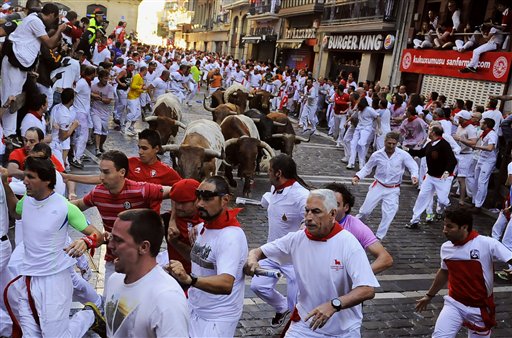"All festivals, of course, are acts of collective myth-making, chances for a nation to advertise its idealized image of itself."Pico Iyer, The Lady and the Monk: Four Seasons in Kyoto (2011)
Ernest Hemingway, The Sun Also Rises (1926)
"You're not a moron. You're only a case of arrested development."
Pamplona, Spain (July 6-14) A million drunks in red kerchiefs. White t-shirts soaked through with beer. Another
lost generation doing Ernest Hemingway. Just before 8 AM, even the atheists start praying to San Fermin, Pamplona's premier patron saint. An explosion from the corral. Twelve half-ton running machines thunder
through the gates of the corral. Six steers, cowbells clanging, herd six fighting bulls on a four minute dash to the Corrida de Torros. A double line of wooden barricades lines narrow medieval streets, enclosing beasts and runners; squeezing haunches and hooves against the shoulders and spines of ten experienced maestros and way too many first-timers who haven’t got a
clue. Day three of the 2013 "Encierro".
No one gored yet.
Don't get all excited. Tejano and I did NOT watch the bulls run in Pamplona (Iruña in Basque). I’d no more join Pamplona’s testosterone-fueled spring break
scene than parachute into Times Square for the New Years Eve ball drop.
But, this past Sunday when my Facebook friend George announced the 2013 Running of the Bulls, he posted such a perfect Hemingway quote, I had to have another look at Pamplona.
Quite frankly, Pamplona didn't make either of our favorites lists when Tejano and I stopped there in May. It certainly didn't look like this:
Quite frankly, Pamplona didn't make either of our favorites lists when Tejano and I stopped there in May. It certainly didn't look like this:
 |
| Revelers are chased by bulls on the Estafeta corner Sunday, July 7, 2013. (AP Photo/Alvaro Barrientos) Read more: http://tinyurl.com/inquirerpamplona |
 |
| 56 Days 23 hours 14 minutes and 59 seconds until El Chupinazo |
| Bull whimsy |
 |
| Pamplona's Plaza del Castelo, lunchtime Friday. A block away, the brave bulls run. |
A protest against budget cuts, colorful, but subdued, greeted us at La Diputacion - El Palacio de Navarre (seat of the Presidency of the Regional Government). We'd seen rallies and marches all over Spain where "El Crisis" has hit hard.
 |
| Hard to get the issue when the banners are in Basque. Flags work in every language. |
(The unfurling of an enormous Basque flag from the front of the building delayed 2013's kick-off for about 20 minutes.) In May, City Hall is a good stop for pilgrims en route to Santiago de Campostelo. The women you see in the foreground have just completed their first 45 miles. Just 455 more miles and a month of walking to go.
There's only so many cathedrals and churches you can take in. After five weeks crossing Spain, we stayed out of Pamplona's, also giving a wide berth to its Opus Dei university and hospitals, legacy of the Franco era when other Basque universities were shuttered.
If you're inspired, you can do an entire circuit of Hemingway sites: his bust outside the Plaza de Torros, his favorite suite at the Hotel La Perla, his life-sized statue by the Bar at Cafe Iruña. You'll have to wait for El Encierro to witness the white beards Papa Hemingway runners. (Find some of these images on my Pamplona Pinterest Board. ) Mostly, Tejano and I took a pass on Hemingway. During his college days in the early 1970's, Tejano and a girlfriend hitchhiked Europe and came to see the bulls run. He said once was more than enough, but heading down a deserted Avenida Roncesvalles, there was Basque artist Rafael Huerta Celaya's irresistible Monument to the Encierro...
Our experience: a bit of a ghost town; a center city devoid of both tourists and locals. We couldn't help but compare its tapas scene to San Sebastian's, it's sites and street life to almost anywhere else in Spain. My advice: Visit for a few hours en route to somewhere else or as part of a day trip. For us, it was the southernmost destination on a larger driving loop through Basque country, Grab a bite to eat. Take your picture by the Encierro Monument or next to Hemingway. Soak up some history, poke your head into a few churches and museums (we were maxed out!), and meander the quiet medieval streets as the City braces itself for another Running of the Bulls. If you're looking for an overnight and a couple of days in a medium-size, low-keyed but interesting destination, there are better places to go. Pamplona's Running of the Bulls/El Encierro by the Numbers
When: Every July 7-14th during the Feast of San Fermin, patron Saint of Pamplona
Duration: About 4 minutes, starting at 8 AM
Where: Four narrow medieval streets that connect the corral and the bullring, about a block off the main square of Pamplona, Spain - or as the Basques whose country it is say: Iruña.
Distance: 903 yards (just over .5 of a mile, for those of us who are spatially challenged)
Casualties: 15 since 1910 -- 13 Spaniards, 1 Mexican, 1 United States ( a 22 year old from Illinois) Injuries: 200-300 a year, though mostly not serious.
Who can participate: Anyone over 18 who isn't drunk and who doesn't incite the bulls.
How many bulls: Six headed for the afternoon bullfights guided by six steers in their midst and another three from behind.
More Information:
|








